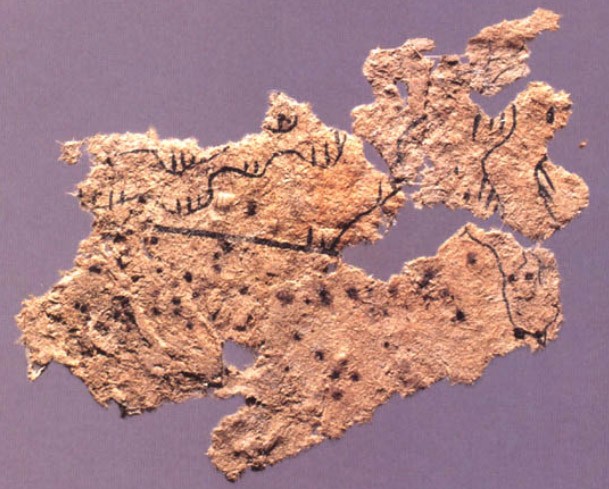Fangmatan Paper Map on:
[Wikipedia]
[Google]
[Amazon]
Fangmatan () is an
 Tomb 5, which was also excavated in 1986, dates to the early Western Han (early 2nd century BCE). The occupant of the tomb was buried with a paper map laid on his chest, but due to water damage only a single fragment (5.6 × 2.6 cm) of the map has survived. The map, which depicts topographic features such as mountains, waterways and roads, is drawn on the oldest extant piece of paper.
Tomb 5, which was also excavated in 1986, dates to the early Western Han (early 2nd century BCE). The occupant of the tomb was buried with a paper map laid on his chest, but due to water damage only a single fragment (5.6 × 2.6 cm) of the map has survived. The map, which depicts topographic features such as mountains, waterways and roads, is drawn on the oldest extant piece of paper.
archeological
Archaeology or archeology is the study of human activity through the recovery and analysis of material culture. The archaeological record consists of artifacts, architecture, biofacts or ecofacts, sites, and cultural landscapes. Archaeology ...
site located near Tianshui
Tianshui is a prefecture-level city in Gansu province, China, and is the province's second-largest city (behind the provincial capital Lanzhou). Located in the southeast of the province, the city strides along the upper reaches of the Wei River a ...
in China
China, officially the People's Republic of China (PRC), is a country in East Asia. With population of China, a population exceeding 1.4 billion, it is the list of countries by population (United Nations), second-most populous country after ...
's Gansu
Gansu is a provinces of China, province in Northwestern China. Its capital and largest city is Lanzhou, in the southeastern part of the province. The seventh-largest administrative district by area at , Gansu lies between the Tibetan Plateau, Ti ...
province. The site was located within the Qin state
Qin (, , or ''Ch'in'') was an ancient Chinese state during the Zhou dynasty. It is traditionally dated to 897 BC. The state of Qin originated from a reconquest of western lands that had previously been lost to the Xirong. Its location at ...
, and includes several burials dating from the Warring States
The Warring States period in Chinese history (221 BC) comprises the final two and a half centuries of the Zhou dynasty (256 BC), which were characterized by frequent warfare, bureaucratic and military reforms, and struggles for gre ...
period through to the early Western Han
The Han dynasty was an imperial dynasty of China (202 BC9 AD, 25–220 AD) established by Liu Bang and ruled by the House of Liu. The dynasty was preceded by the short-lived Qin dynasty (221–206 BC) and a warring int ...
.
Tomb 1
The date of the burial of Tomb 1 was approximately 230 to 220 BCE at the very end of theWarring States
The Warring States period in Chinese history (221 BC) comprises the final two and a half centuries of the Zhou dynasty (256 BC), which were characterized by frequent warfare, bureaucratic and military reforms, and struggles for gre ...
period; it was excavated in 1986. The tomb contained a number of long-lost texts written on bamboo slips
Bamboo and wooden strips ( zh, s=简牍, t=簡牘, first=t, p=jiǎndú) are long, narrow strips of wood or bamboo, each typically holding a single column of several dozen brush-written characters. They were the main media for writing documents ...
, including almanac
An almanac (also spelled almanack and almanach) is a regularly published listing of a set of current information about one or multiple subjects. It includes information like weather forecasting, weather forecasts, farmers' sowing, planting dates ...
s ( Rishu 日書), legal texts, medical works, and seven maps. The maps are drawn in black ink on four rectangular pieces of pine wood, 26.7 cm in length and between 15 and 18.1 cm in width, and depict the tributary river systems of the Jialing River
The Jialing River, formerly known by numerous other names, is a major tributary of the Yangtze River in the Sichuan Basin. It is named after the Jialing Valley in Feng County, Shaanxi through which it flows.
The Jialing River's most notable c ...
in modern Sichuan
Sichuan is a province in Southwestern China, occupying the Sichuan Basin and Tibetan Plateau—between the Jinsha River to the west, the Daba Mountains to the north, and the Yunnan–Guizhou Plateau to the south. Its capital city is Cheng ...
province. The areas covered by the seven maps overlap, but in total they cover 107 × 68 km in area.
Tomb 5
 Tomb 5, which was also excavated in 1986, dates to the early Western Han (early 2nd century BCE). The occupant of the tomb was buried with a paper map laid on his chest, but due to water damage only a single fragment (5.6 × 2.6 cm) of the map has survived. The map, which depicts topographic features such as mountains, waterways and roads, is drawn on the oldest extant piece of paper.
Tomb 5, which was also excavated in 1986, dates to the early Western Han (early 2nd century BCE). The occupant of the tomb was buried with a paper map laid on his chest, but due to water damage only a single fragment (5.6 × 2.6 cm) of the map has survived. The map, which depicts topographic features such as mountains, waterways and roads, is drawn on the oldest extant piece of paper.
Notes
Bibliography
* *. *. * * {{Prehistoric cultures of China Archaeological sites in China Tianshui